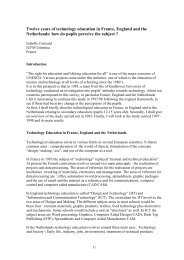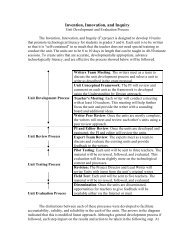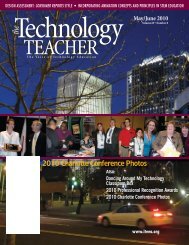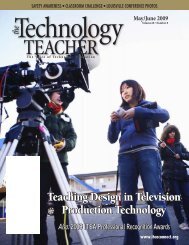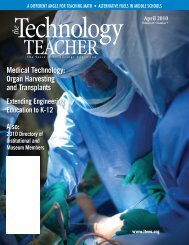NOVEMBER 2002 VOL. 62 NO. 3 - International Technology and ...
NOVEMBER 2002 VOL. 62 NO. 3 - International Technology and ...
NOVEMBER 2002 VOL. 62 NO. 3 - International Technology and ...
- No tags were found...
Create successful ePaper yourself
Turn your PDF publications into a flip-book with our unique Google optimized e-Paper software.
RESOURCES IN TECH<strong>NO</strong>LOGYMonday, August 13, <strong>2002</strong>, Dr.Panayiotis Zavas, along with amarried couple identified only bytheir first names, Bill <strong>and</strong> Kathy,appeared on CNN’s “Connie ChungTonight” announcing that they willhave the first cloned baby. The procedureis to begin as soon as September,in an undisclosed location outside ofthe U.S. (Spears, <strong>2002</strong>). The genie isout of the bottle, <strong>and</strong> only a technologicallyliterate society will be able todecide how this new biotechnologyrevolution will affect the human race.Cloning DefinedCloning is fundamental to most livingthings, since the body cells of plants<strong>and</strong> animals are clones ultimatelyderived from the mitosis of a singlefertilized egg. A clone is the name for agroup of organisms or other livingmatter with exactly the same geneticmaterial. The word clone has beenapplied to cells as well as to organisms,so a group of cells stemming from asingle cell is also called a clone(Encarta’01, <strong>2002</strong>). Cloning is theproduction of an exact genetic duplicateof a living organism or cell. Today,for many people, the word “clone” canbe confusing <strong>and</strong> hard to associatewith a simple definition. Cloningoccurs often in the natural world.With humans <strong>and</strong> other higher animals,clones form naturally throughgenetically identical multiple births.Single-celled organisms, such as bacteria,protozoa, <strong>and</strong> yeast, producegenetically identical offspring throughasexual reproduction. These offspringdevelop from only one parent <strong>and</strong> areconsidered clones. Plants can alsoreproduce asexually through a processcalled vegetative propagation. Manyplants show this by producing suckers,tubers, or bulbs to colonize the areaaround the parent. Hydras, flatworms,<strong>and</strong> other simple animals can becloned through asexual reproductionor the process of regeneration(Worldbook, <strong>2002</strong>).20Cloning, as an artificial technique,is achieved through nuclear transfer.Nuclear transfer is taking the nucleusof a cultured cell <strong>and</strong> transferring it toan unfertilized egg cell, which has hadits genetic material removed. To effectivelyunderst<strong>and</strong> the science ofhuman cloning, the term cloning mustbe further developed to distinguishbetween two basic applications, reproductivecloning <strong>and</strong> therapeuticcloning. Reproductive cloning uses thecloning procedure to produce a clonalembryo that is implanted in a woman’swomb with intent to create a fullyformed living child. See Figure 1.Therapeutic cloning uses the cloningprocedure to produce a clonal embryo,but instead of being implanted in awomb <strong>and</strong> brought to term it is usedto generate stem cells, as shown inFigure 2 (ARHP, <strong>2002</strong>).At the heart of these two distinctionsbetween cloning lies the basis formost people’s arguments either for oragainst human cloning. There arethose who oppose reproductivecloning but support therapeuticcloning. Others are against both typesof cloning because they are eitheropposed to the destruction of embryosthat result from therapeutic cloning orbecause they feel the acceptance oftherapeutic cloning will lead to theacceptance of reproductive cloning<strong>and</strong> eventually to human geneticmanipulation.History of CloningSince ancient times, people haveknown that invertebrates, (animalswithout backbones), such as earthworms<strong>and</strong> starfish, can be clonedsimply by dividing them into twopieces. Each piece regenerates into acomplete organism. Scientific attemptsto clone vertebrates would prove to bemuch harder. Beginning in the late1800s, scientists began to question whya cell develops to become specializedin function despite the fact that allcells in an organism originate from thesame fertilized egg. In 1902, HansSpemann, a German embryologist,split a two-celled salam<strong>and</strong>er embryoin two. Following the division, eachcell grew to be an adult salam<strong>and</strong>er.Spemann’s success with splitting aFigure 1. Reproductive cloning uses the cloning procedure to produce a clonalembryo. Here the nucleus of a cell is removed <strong>and</strong> replaced with the nucleus fromanother cell taken from hair, tissue, or muscle that results in a clonal zygote to producea clonal embryo. This process is accomplished at the cellular level under highlycontrolled conditions.THE TECH<strong>NO</strong>LOGY TEACHER • November <strong>2002</strong>



